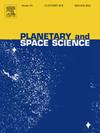Thermal and electrochemical properties of a mixture of lunar regolith simulant (FJS-1) and CaF2
IF 1.7
4区 物理与天体物理
Q3 ASTRONOMY & ASTROPHYSICS
引用次数: 0
Abstract
To establish the electrochemical reduction process of lunar regolith as an in-situ resource utilization technology on the Moon, it is crucial to prepare a high-temperature electrolytic melt that has a composition suitable for electrolysis. In this study, we propose a mixed melt consisting of lunar regolith, which comprises metal-oxide compounds, and CaF2, which can be collected from fluorapatite on the Moon's surface. To characterize the lunar regolith-CaF2 system, the thermal and electrochemical properties of a mixture of a lunar mare regolith simulant (FJS-1) and CaF2 were investigated. The differential thermal analysis curves measured for various compositions of FJS-1 and CaF2 found that the eutectic temperature was 1275 K at FJS-1:CaF2 = 90:10 wt%, which is lower than the melting point of FJS-1, 1393 K. By electrochemical impedance spectroscopic technique, the electrical resistance of the melts at 1673 K was found to be 43 Ω for the FJS-1 melt, while the mixed melt of FJS-1 and CaF2 (80:20 wt%) was found to be 5 Ω. The XRD analysis of the solidified melts revealed that the mixed melts' unique physical properties were due to the formation of chemical bonding of F− ions due to CaF2 and metal ions due to FJS-1. Furthermore, the electrochemical behavior of the mixed melt was investigated, demonstrating the electrodeposition of metals such as Si and Al derived from FJS-1. The reported data will provide new guidelines for designing electrolytic systems on the Moon, expanding the possibilities for controlling the temperature and electrochemical operations.

月球风化模拟物(FJS-1)和CaF2混合物的热电化学性质
要将月壤的电化学还原过程建立为月球就地资源利用技术,关键是要制备一种具有适合电解成分的高温电解熔体。在这项研究中,我们提出了一种混合熔体,由月球风化层和CaF2组成,其中包括金属氧化物化合物,CaF2可以从月球表面的氟磷灰石中收集。为了表征月球风化层-CaF2体系,研究了月球风化层模拟物(FJS-1)和CaF2的混合物的热学和电化学性质。对FJS-1和CaF2的不同组分进行差热分析,FJS-1:CaF2 = 90:10 wt%时共晶温度为1275 K,低于FJS-1的熔点1393 K。通过电化学阻抗谱技术,FJS-1熔体在1673 K时的电阻为43 Ω,而FJS-1和CaF2的混合熔体(80:20 wt%)的电阻为5 Ω。对固化熔体的XRD分析表明,混合熔体具有独特的物理性能是由于CaF2与FJS-1形成了F−离子和金属离子的化学键。此外,对混合熔体的电化学行为进行了研究,证明了FJS-1衍生的Si和Al等金属的电沉积。报告的数据将为设计月球上的电解系统提供新的指导方针,扩大控制温度和电化学操作的可能性。
本文章由计算机程序翻译,如有差异,请以英文原文为准。
求助全文
约1分钟内获得全文
求助全文
来源期刊

Planetary and Space Science
地学天文-天文与天体物理
CiteScore
5.40
自引率
4.20%
发文量
126
审稿时长
15 weeks
期刊介绍:
Planetary and Space Science publishes original articles as well as short communications (letters). Ground-based and space-borne instrumentation and laboratory simulation of solar system processes are included. The following fields of planetary and solar system research are covered:
• Celestial mechanics, including dynamical evolution of the solar system, gravitational captures and resonances, relativistic effects, tracking and dynamics
• Cosmochemistry and origin, including all aspects of the formation and initial physical and chemical evolution of the solar system
• Terrestrial planets and satellites, including the physics of the interiors, geology and morphology of the surfaces, tectonics, mineralogy and dating
• Outer planets and satellites, including formation and evolution, remote sensing at all wavelengths and in situ measurements
• Planetary atmospheres, including formation and evolution, circulation and meteorology, boundary layers, remote sensing and laboratory simulation
• Planetary magnetospheres and ionospheres, including origin of magnetic fields, magnetospheric plasma and radiation belts, and their interaction with the sun, the solar wind and satellites
• Small bodies, dust and rings, including asteroids, comets and zodiacal light and their interaction with the solar radiation and the solar wind
• Exobiology, including origin of life, detection of planetary ecosystems and pre-biological phenomena in the solar system and laboratory simulations
• Extrasolar systems, including the detection and/or the detectability of exoplanets and planetary systems, their formation and evolution, the physical and chemical properties of the exoplanets
• History of planetary and space research
 求助内容:
求助内容: 应助结果提醒方式:
应助结果提醒方式:


